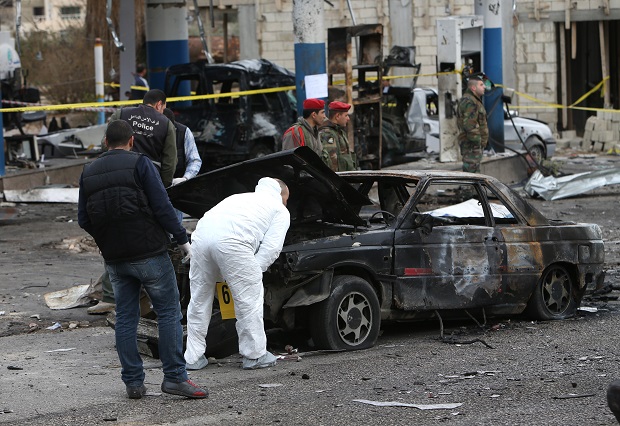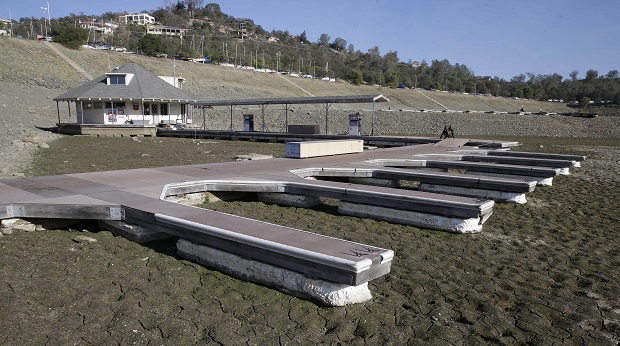Syria’s civil war linked partly to drought, global warming

In this Feb. 2, 2014 file photo, Lebanese police inspectors, investigates the site of a deadly car bomb that exploded near a gas station, in the predominately Shiite town of Hermel, about 10 miles from the Syrian border in northeast Lebanon. Global warming worsened record droughts in war-torn Syria and peaceful California, contributing to the unrest that has torn the Middle Eastern country apart, two new studies say. In what scientists say is one of the most detailed and strongest connections between violence and human caused climate change, researchers from Columbia University and the University of California Santa Barbara trace Syria’s drought to the collapse of farming to the migration of 1.5 million farmers to the cities to poverty to civil unrest. Syria’s drought started in 2007 and went until at least 2010– maybe longer with weather records harder to get in wartime. AP
WASHINGTON, United Staes — The conflict that has torn Syria apart can be traced, in part, to a record drought worsened by global warming, a new study says.
In what scientists say is one of the most detailed and strongest connections between violence and human-caused climate change, researchers from Columbia University and the University of California Santa Barbara trace the effects of Syria’s drought from the collapse of farming, to the migration of 1.5 million farmers to the cities, and then to poverty and civil unrest. Syria’s drought started in 2007 and continued until at least 2010 — and perhaps longer. Weather records are more difficult to get in wartime.
“There are various things going on, but you’re talking about 1.5 million people migrating from the rural north to the cities,” said climate scientist Richard Seager at Columbia, a co-author of the study published Monday in the journal Proceedings of the National Academy of Sciences. “It was a contributing factor to the social unravelling that occurred that eventually led to the civil war.”
Not the cause
The study’s authors do not claim climate change caused Syria’s civil war. It’s not that simple. Lead author Colin Kelley at the University of California said there are numerous factors involved, including the oppressive Assad regime, an influx of more than 1 million refugees from Iraq, the tumult of the Arab Spring, as well as the drought. Kelley and Seager said they couldn’t say which factors were the most important.
But, Seager said, this is the “single clearest case” ever presented by scientists of climate change playing a part in conflict because “you can really draw a blow-by-blow account with the numbers.”

In this Nov. 17, 2014 file photo, boat slips sit on the dry lake bed at Brown’s Marina at Folsom Lake, near Folsom, California. Global warming worsened record droughts in war-torn Syria and peaceful California, contributing to the unrest that has torn the Middle Eastern country apart, two new studies say. AP
Kelley and Seager do statistical and computer simulation analysis to connect global warming to the multi-year drought, finding that such dry spells are two to three times more likely because of human-caused heat-trapping carbon dioxide in the atmosphere than under natural conditions. The connection between climate change and drought in the eastern Mediterranean is one of the most robust in science, said Seager and other scientists.
They also show that Syria’s temperature has risen by nearly 2 degrees Fahrenheit (1 C) since 1900, which adds to drying through evaporation, and winter rainfall has dropped, too. Three of the four worst multi-year droughts in Syria’s history have occurred in the last 30 years, Kelley said.
‘Quite compelling’
Martin Hoerling, a National Oceanic and Atmospheric Administration meteorologist, praised the study and the arguments as “quite compelling.” Hoerling, who has produced studies dismissing global warming’s role in some U.S. droughts including California’s, said the Kelley paper makes a strong case for the Syrian drought and the violence being connected to climate change.
David Titley, a Pennsylvania State University scientist and retired Navy admiral, said the paper does a good job linking climate change and drought to “varsity-level instability.”
“Reading this paper is like reading the analysis of an airline crash,” Titley wrote in an email. “There is a chain of events stretching back over 40 years that has led to the present calamitous conditions. The change in climate, forced by greenhouse gases, was one of the key events in this tragic story.”
Robert Danin, who is an expert in Middle Eastern politics as a former State Department official, said it’s probably correct to say the drought is one factor in the chaos in Syria. But Danin, now a senior fellow at the Council on Foreign Relations, cautions about taking the link too far.
Affecting millions
But the link between climate change and conflict has been suggested often in recent years. Last October, then-Defense Secretary Chuck Hagel unveiled a Pentagon report that made exactly that point. “Droughts and crop failures can leave millions of people without any lifeline, and trigger waves of mass migration,” Hagel said.
Also last year the Nobel Peace Prize winning Intergovernmental Panel on Climate Change concluded: “Human security will be progressively threatened as the climate changes.”
In a separate study, also published in the same journal, Stanford University climate scientist Noah Diffenbaugh, said the long-time upward trend in California’s temperatures have caused the current drought there to be worse, regardless of the initial cause of lack of rain. Diffenbaugh didn’t see much of a change in rainfall, but a big one in terms of warming.
In the past, he said, some years when there was little rain, it was cool and that didn’t cause droughts that were as severe. The heat didn’t add to evaporation and what winter precipitation there was came down as snow, which is easier to store than rain, Diffenbaugh said. Now, when there’s little rain, there is an 80 percent chance the temperature will be high and worsen the drought, Diffenbaugh said. And in the future, that moves up to close to 100 percent, he said.
While they are different places, there is a connection between the two droughts and climate change, Kelley said. It shows that a wealthy United States can bounce back from a big drought and a country like Syria sometimes can’t, he said.
__
Online:
Journal: https://www.pnas.org
RELATED STORIES
Legarda pushes for global united front vs climate change